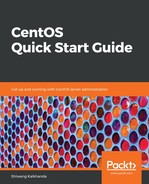The setgid special permission is used to enable group inheritance from the parent directory. When setgid is set on a directory, then files created in that directory will inherit the group affiliation from the parent directory, instead of inheriting it from the user who creates the file. It is generally used on collaborative (shared) directories to automatically change a file from the default user private group to the shared group.
The following command line is used to view the existing permission of a directory:
$ ls -ld mydir
The following example illustrates the usage of the chmod command to add the setgid permission to a directory:
$ chmod g+s mydir
or
$ chmod 2770 mydir
$ ls -ld mydir
Here is a table listing special permissions and their effect on files and directories:
|
Special permission |
Numerically fourth-digit weightage |
Effects on files |
Effects on directories |
|
setuid (u+s) |
Setuid= 4 |
Files are executed as the user that owns the file, not the user running that file |
No effect |
|
setgid (g+s) |
Setgid = 2 |
Files are executed as the group that owns the file |
Enables group inheritance. Files created in the directory have their group owner set as the group owner of the directory |
|
sticky bit (o+t) |
Sticky bit = 1 |
No effect |
Only the root or the owner of the files can delete the files from the directory with a sticky bit set |
